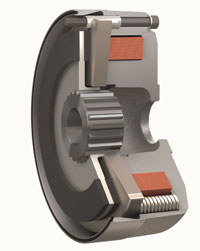
Posted to News on 25th Jan 2019, 00:00
Safety brakes are easy to install
Safety brakes have to protect people and systems and in emergencies also save lives. But ease of integration is also a requirement, so safety brakes from Mayr Power Transmission are supplied ready to install. For users, this means the greatest possible safety and simple installation without additional effort.

Let’s consider some essential safety requirements: a crane can’t have the possibility of tipping over, even in high winds and storms; storage and retrieval machines must come to a stop reliably and as quickly as possible even in case of emergency stop or power failure; and workers must be able to load and unload machining centres without being put at risk. In order to protect people and materials, safety brakes are used in machines and systems which brake movements to a standstill instantly in case of emergency or which hold certain positions accurately to the millimetre.
These are components which save lives in emergencies. This task does not permit quality standards to be lowered, as safety does not allow for compromises. For this reason, Mayr Power Transmission consistently takes fundamental safety principles into account during development and production. For example, the safety brakes have been designed so that they facilitate as easy and rapid installation and application as possible, while simultaneously excluding adjustment errors. The constructionally specified, tested and unchangeable working air gap makes this possible.
Electromagnetic safety brakes work in accordance with the fail-safe principle. This means that they are failure-proof and closed when de-energised, so also in case of power failure or emergency stop. The braking torque is generated through the force stored in the thrust springs. When the power is switched on, a magnetic field builds up in the brakes. The armature disk is thus pulled against the spring pressure to the coil carrier leaving the rotor free, ie the brake is released and the shaft can rotate freely.
Safety brakes such as the ROBA-stop-M series from Mayr have fixed distance bushings, meaning that they have been constructionally designed so that the correct air gap results automatically due to the precise positioning of the coil carrier (made from steel or cast iron) in the brake. Users merely have to screw on the brake and do not have to undertake any further adjustment work on the air gap or switches for wear or release monitoring. Mayr brakes are therefore designed as safety brakes from the start, and the user does not bear responsibility for correct brake function. This contrasts with more traditional designs that have adjustable distance bolts, and where users must adjust the switches and air gap absolutely accurately during installation – and this in multiple positions.
This not only requires time and trained personnel, but also generates many error sources and therefore safety risks. If the air gap is too large, the brake will not function. If the air gap is not straight – ie if the coil carrier is not parallel to the rotor – this may influence the braking torque. In addition, skewed adjustment leads to uneven loads on the rotor and therefore to uneven temperature development. If, however, the air gap is too small, it can cause grinding and thus produce high levels of unnecessary wear. In addition, the lining can swell up and under certain circumstances can block the brake completely. The switch for brake monitoring may also cease to function reliably.
Depending on the application, incorrect adjustment of the distance bolts can therefore severely impact the safety. In cases of damage, it is often difficult to trace who bears responsibility for incorrect adjustments – the motor manufacturer or a worker in the field, for example during servicing or maintenance work. The brake manufacturers generally bear no responsibility for incorrectly adjusted distance bolts. This is not the case for Mayr. Not only does the company ensure that any adjustment errors are excluded from the start through the brake design, but it also conducts a careful final inspection.
Every safety brake which leaves the plant must pass a 100% inspection after complete assembly and adjustment. Here function-relevant parameters such as pull-in and drop-out voltage, coil resistance, dielectric strength of the coil, insulation between the coil and the housing, axial force, armature disk stroke and the function of the switching condition monitoring are determined.
All the measurement values determined are archived together with the associated serial number of the brake in an electronic database. This guarantees 100 % traceability. These comprehensive and unique tests and inspections are central components of the Mayr understanding of safety and quality, ensuring that the safety brakes work reliably from the start.
10/11 Valley Road Business Park
Valley Road
BD21 4LZ
UNITED KINGDOM
+44 (0)1535 663900






